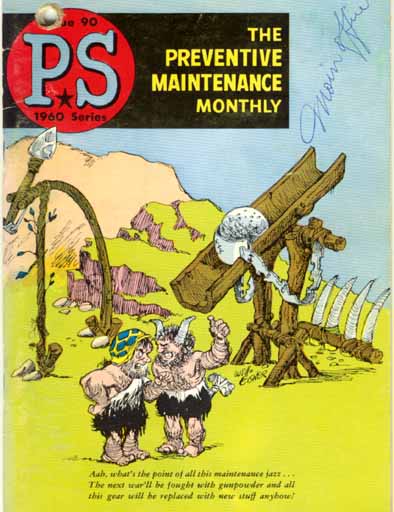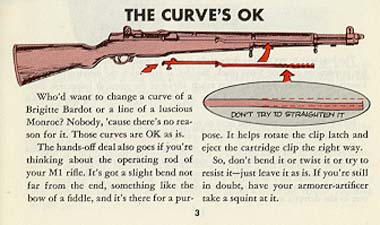PS Magazine The Preventative Maintenance Monthly History ©
For those who were in the service and remember reading the publication, for those who have read the various postings of PS Magazine articles on the different message boards, and for those who are unaware of its existence, here is a small history of the publication.
Background
The basis of PS Magazine actually reaches back to WWII when the Ordnance Dept. had two regular publications. They were Army Motors, which covered motor vehicle information in great depth, and The Ordnance Sergeant, a monthly magazine that went into high echelon changes covering the whole ordnance spectrum. The success of these two monthly publications laid the eventual groundwork for PS Magazine. Will Eisner, the WWII artist for Army Motors, was chosen to illustrate the new publication. The first issue of PS Magazine was printed in June, 1951 during the Korean War. The purpose of the magazine was SPEED. As the name implies, PS was a postscript to the various technical manuals and technical bulletins. These other forms of publications often took a long time to get the message out and sometimes lacked the emphasis of maintaining equipment at the user level.
The first few issues of PS Magazine were printed on newsprint, just like the old newspaper comics. The paper was not very durable, and today some of the earliest issues do not survive in quantity. Publication and distribution was sporadic during the first year of issue; some of those early issues covered a period of several months. The magazine was published in a comic format with Will Eisner doing the comic illustrations. The thought was that if you add a little humor and a pretty girl, you would get GI's to read every issue.

My personal favorite, the cover from 1960, Issue #90, shows the humor involved in PS Magazine. The two cavemen are having an argument over the future of weapons.
"Aah, what's the point of all this maintenance jazz....The next war will be fought with gunpowder and all this gear will be replaced with new stuff anyhow!"
The magazine was also well known for its tips on how to properly use issued equipment. Most technical publications were not user friendly. PS Magazine's goal was to impart knowledge left out of those technical publications. It did that by the use of many different characters over the years. However there were two main characters which were the stars.
Every month beautiful blond Miss Connie Rodd (a takeoff on “con rod”, the connecting rod in an engine) and Sgt. Half Mast, answered inquiries, handed out maintenance tips, and kept the troops informed about all sorts of new developments. The areas covered were not limited to ordnance. Miss Rodd and Half Mast tackled topics of Quartermaster, Engineer, Communications, and many other Army Branches. The areas covered for the Ordnance Department ranged from jeeps to the 20-ton dump trucks and tanks, bayonets, scabbards, arms racks, and from small arms up to 120mm Anti Aircraft Guns, rockets and missiles. It was also not unusual to see PS covering Fork Lifts, Road Graders, and other very large items that were not even the responsibility of Ordnance. The magazine was printed in various locations: Aberdeen Proving Grounds for a very short time, Raritan Arsenal in NJ, and Ft Knox in Kentucky. The Government Printing Office prints the magazine today.
The Distribution Process: Each unit requested multiple copies of PS Magazine and decided its own requirements and distribution. An example for a typical Headquarters Company would be enough copies to cover the Motor Pool, Commo Platoon, Supply & Transportation Platoon, Medic Platoon, Arms Room, Supply Room, Heavy Mortar Platoon, Orderly Room and possibly one for the Commanding Officer. A Rifle Company would order enough to cover each Rifle Platoon, Supply Room, Orderly Room, Arms Room, and possibly the Commanding Officer. It was not unusual for each Battalion Message Center (part of the Commo Platoon) to receive 25-35 copies of the current issue to be delivered to the units.
The unit could request as many as it wanted, paying a small price out of its operating fund for each copy. Needless to say plenty were printed over the years, but like approximately 5 1/2 million M1 rifles, time has taken its toll. Many were thrown away without anybody even opening the pages. Copies that were supposed to be passed on to other GI’s ended up in the unit dumpster. The greatest preservers of PS Magazines were usually the Motor Pools. The magazine had a much heavier emphasis on trucks than small arms, so it has always been a favorite of automotive mechanics. It was not unusual to see recent PS Magazine in the motor pool area of active or reserve units, a hole punched in the publication, hanging from a nail.

Each month several articles were written on the prevention of problems and various tips. This issue from Issue #96, December of 1960, shows the problem of GI's not knowing the curve of the M1 Rifle's operating rod tube. Tips included the proper way to use a piece of equipment, or a newer version when something became obsolete.
Aside from the different locations at which PS Magazine was printed, it changed in character as time passed. In addition to covering equipment currently assigned to the masses, it often covered the newest items that just very select units would have on hand.
PS Magazine also changed with the changes within the Army and society. During the mid 1960’s most articles were written with a Vietnam theme. As the 1970’s approached, women and blacks began to join the military in greater numbers, and PS Magazine began to feature more female and black characters.
There are a few different types of collectors of PS Magazine. Today there are several dozen serious collectors who are attempting to complete the entire set. But the majority of collector interest comes from individuals that served from the mid 1950's through the mid 1970's, the period known as the "Golden Age" for PS Magazine. Many from this time period are trying to get all the PS Magazines that were printed during their three or four years of service. Reading the familiar articles serves as a connection to their past.
Currently a large interest is from the veterans from the Vietnam period. The years 1962 thru 1973 seem to be in the greatest demand. I could continue with all sorts of trivia about the publication, but that is not my intent.
In a parting note, I say that PS Magazine is still in print today, but it is a far cry from what it was at its height of popularity. In the 1980’s the publication’s paper was cheapened and the bright colors used in the artwork were replaced by less intense ones. Every weapon of today's interest was covered during PS Magazine's golden years of 1957 to 1973. Instead of reading about vintage small arms, recoilless rifles, and M series of Jeeps, today’s publication covers areas like GPS systems, high tech field computers, laser munitions systems, and commercial trucks. Somehow it just isn’t the same!!!
To contact me..... This email address is being protected from spambots. You need JavaScript enabled to view it.">CLICK HERE
I have produced a CD covering many of the small arms topics from 1951 thru 1973. To learn more about this CD CLICK HERE
I also have a small number of duplicate issues for sale. CLICK HERE

